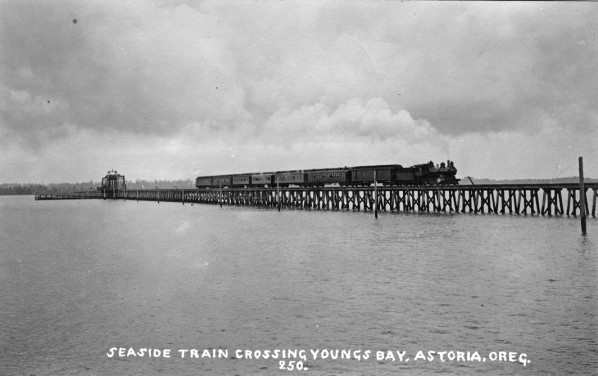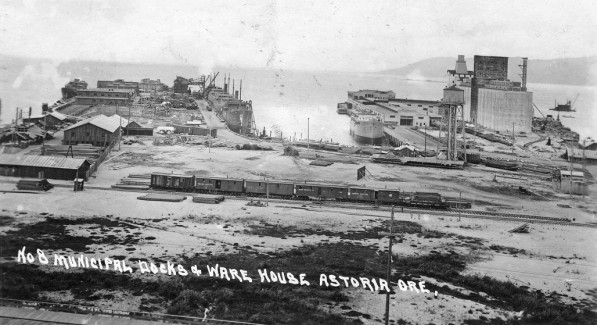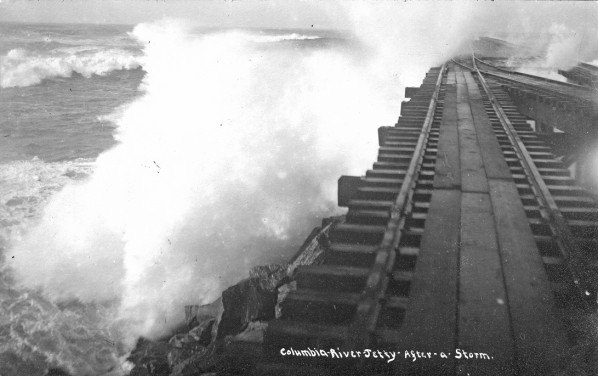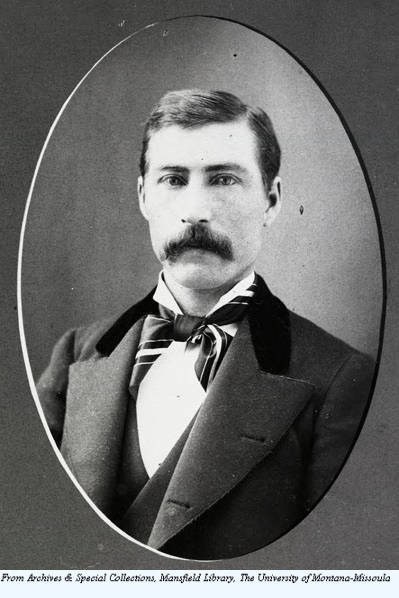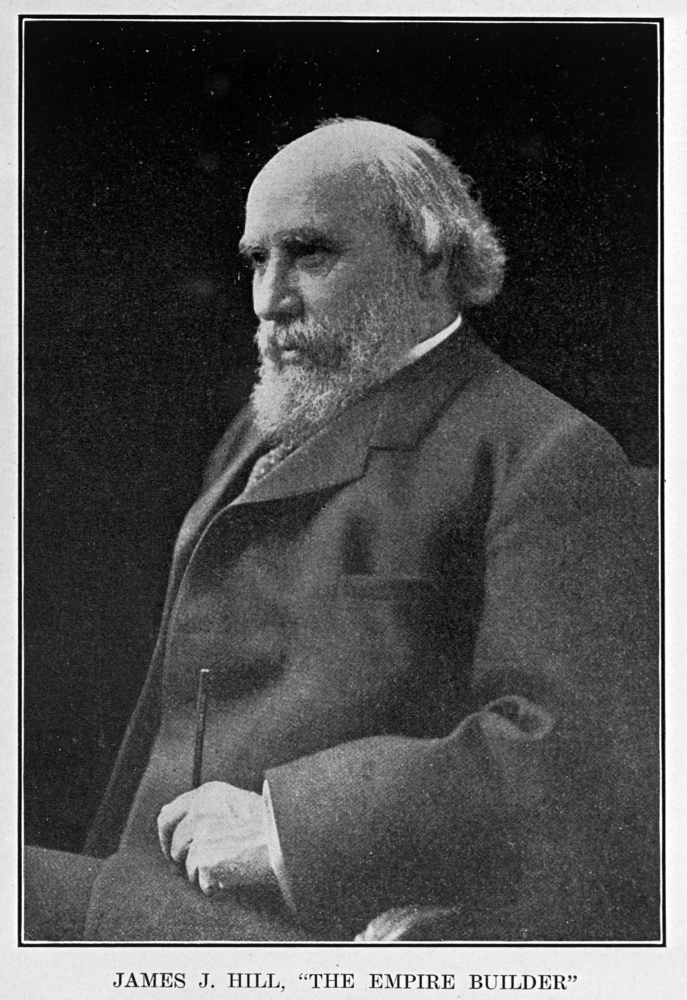Ever since Astoria was founded at the mouth of the Columbia River in 1811, residents dreamed of their town becoming a booming port. Once ships crossed the treacherous bar at the river’s mouth, however, the vessels simply continued to Portland. Townspeople, persuaded that a railroad could transform Astoria into the entrepôt to the Northwest, began agitating for a line as early as 1853. Five years later, the Oregon territorial legislature granted a charter for a railroad from Astoria to Eugene. It was the first of many failed attempts.
Finally, in 1883, with the coming of the transcontinental railroad to the West, Astoria assumed that they would be connected to the rest of the nation. By the time the Northern Pacific reached Portland, however, the railroad was financially overextended and stopped fifty-eight miles short, at Goble, effectively making Portland the western terminus of the line.
As a result, Astorians were faced with creating their own incentives to entice a railroad builder, and they offered a cash bonus for a capitalist to take on construction. Promoter William Reid took the bait and began grading a roadbed from Astoria south along the coast. He hoped to connect to Ben Holladay's Oregon & California (O&C) rail line at Hillsboro. By the mid-1880s, the O&C line ran south from Portland to Roseburg, and would soon reach the California border near the city of Klamath Falls.
Reid was backed by railroad tycoon C.P. Huntington, but the deal fell through when Astorians attempted to dump Reid in favor of Huntington. Nonetheless, Reid had completed a line from Astoria to Seaside. Although in financial limbo, the line was now in a position to run up the Nehalem River to Portland or down the coast to connect to the Oregon Pacific railroad line that T. Egenton Hogg was then building between Corvallis and Newport.
During the 1890s, Astoria residents heaped subsidy upon subsidy on the promise of a railroad, offering thousands of acres of prime real estate plus $300,000 to lure an investor to bring a line to the town. Six attempts between 1892 and 1894, however, failed to secure enough capital. Then, in December 1894, Astoria city leaders accepted a proposal from Montana businessman Andrew B. Hammond, who had both the construction experience and the financial backing to complete the job. Instead of the Nehalem route, Hammond decided to follow the Columbia River to Goble. Finally, after half a century of anticipation, the Astoria and Columbia River Railroad (A&CR) line was completed in May 1898.
Although the Astorians were banking on freight traffic, the tourist trade from Portland to the coastal resorts proved to be a mainstay of the A&CR. The railroad was immediately popular with Portlanders who sought to escape the summer heat. Special weekend service was known as the “Daddy Train,” as businessmen could leave Portland on Saturday, spend the weekend with their families vacationing on the coast, and be back at work on Monday morning. The emerging middle class, with its increased leisure time, coincided with the new rail access to form the beginning of a major tourism industry along the Oregon coast. During the next six years, the population of Seaside tripled.
In the end, it was the timber industry that benefited the most from the A&CR, as the railroad now accessed the forests of the Oregon Coast Range that, according to the Oregonian, had been “shut off by an impenetrable wall” of rugged mountains and twisting river valleys.” By 1910, Astoria had 15,000 people, and its lumber mills were running day and night, producing more than 263 million board feet of lumber a year, almost all of it for export. The railroad and logging operations allowed neighboring Columbia County’s population to nearly double from 6,237 in 1900 to 10,580 ten years later.
With the A&CR posting yearly profits, Hammond began playing railroad magnets E.H. Harriman of the Union Pacific and James J. Hill of the Northern Pacific against each other and repeatedly announced expansion plans that threatened their domination of the Oregon market. Although Hammond had offered the Astoria line to Harriman a few years earlier for $4 million, he increased the price to $5 million in 1907. Hill snapped up the deal. The following year, Hill completed the Spokane Portland & Seattle Railway (SP&S), which over the next few years absorbed the A&CR.
By the 1990s, after serving Astoria for nearly a century, the old A&CR was abandoned or sold off by the Burlington Northern Railroad, which had absorbed the SP&S.
-
![Image Seaside train crossing Young's Bay, 1912]()
Seaside train crossing Young's Bay, 1912 .
Image Seaside train crossing Young's Bay, 1912 Courtesy Oregon State Univ. Libraries, willliams:g_cr
-
![Astoria municipal docks, 1918]()
Astoria municipal docks, 1918.
Astoria municipal docks, 1918 Courtesy Oregon State Univ. Libraries, willliams:g_cr
-
![Columbia River jetty, 1910]()
Columbia River jetty, 1910.
Columbia River jetty, 1910 Courtesy Oregon State Univ. Libraries, willliams:g_cr
Related Entries
-
![Andrew B. Hammond (1848-1934)]()
Andrew B. Hammond (1848-1934)
Sensing opportunity following the Panic of 1893, Montana businessman An…
-
![James J. Hill (1838-1916)]()
James J. Hill (1838-1916)
James Jerome Hill was one of the United States’ preeminent railroad man…
Related Historical Records
Map This on the Oregon History WayFinder
The Oregon History Wayfinder is an interactive map that identifies significant places, people, and events in Oregon history.
Further Reading
Gordon, Greg. “Economic Phoenix: How A. B. Hammond Used the Depression of 1893 and a Pair of Defunct Oregon Railroads to Build a Lumber Empire.” Oregon Historical Quarterly 109:4 (Winter 2008), 598-620.
Robbins, William G. Landscapes of Promise: The Oregon Story, 1800–1940. Seattle: University of Washington Press, 1997.
Scott, Leslie. “History of Astoria Railroad.” Oregon Historical Quarterly 15:4 (Dec. 1914), 221–240.



